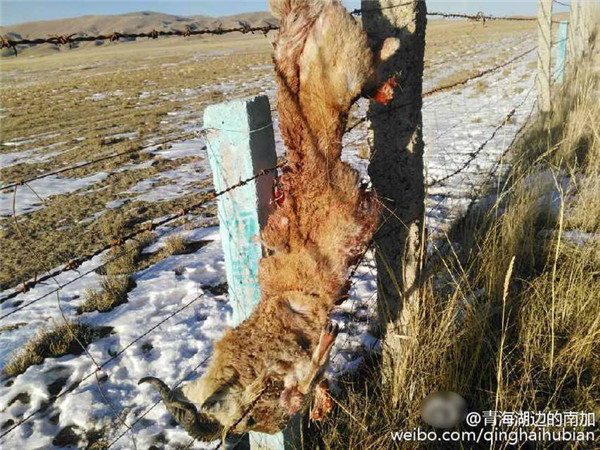Deaths of endangered gazelles dismay Internet
Xinhua, February 26, 2016 Adjust font size:
 |
|
The deaths of seven Przewalski's gazelle have aroused debate over whether grassland fences should be removed completely. [Photo/Weibo.com] |
Shao Wenjie, a volunteer with NGO Nature University, said on Sina Weibo that completely removing the fences was the only solution.
In an answer to a netizen's question, Shao said the fences are as harmful as highways, chopping the once endless grasslands into pieces, fragmenting the gazelle habitat, and genetically isolating groups.
Przewalski's gazelles are sometimes able to jump over or squeeze under fences, but may be seriously hurt by the barbed wire or become fatally entangled.
Wu Yonglin, a gazelle researcher at Qinghai Lake national nature reserve, revealed that there is no specific data on how many gazelles are killed by fences every year, but in 2010, the number was between 30 and 40.
The local government has suggested lowering the height of fences and taking off the barbed wire rather than completely removing them, considering their function and the interests of the herdsmen.
According to staff at the reserve, the standard fences are around 1.5 meters high, which may kill or hurt the gazelles, especially the old and pregnant. If the fences could be lowered to 1.2 meters and the barbed wire taken off, the gazelles would jump over them easily.
Since 2009, Qinghai government has spent more than 8.4 million yuan (around 1.3 million U.S. dollars) on protecting Przewalski's gazelle, including restoring habitat, lowering fences, removing barbed wire and building ponds.
Wang Enguang said they had adjusted around 500 kilometers of fences around the lake to help isolated groups intermingle. Complete removal of all fences, as desired by NGOs and volunteers, is not possible at present.
The range was divided into patches and assigned to individual households in the early 1980s when the government introduced a household responsibility contract system to transform the economy and preserve pasture. More and more grassland has since been fenced as paddocks.
Animal husbandry is one of the main income sources for the area around Qinghai Lake. Fences were built by herdsmen to protect their livestock from predators and mark their ownership.
It is not easy to persuade them to remove the fences, as found by another report published by several universities in 2014. Most herdsmen around Qinghai Lake were very willing to reduce the height of their fences, but few were willing to completely remove them without compensation.
Qinghai Forestry Department will lower 98 kilometers of fences to 1.1 meters and take the barbed wire off 150 km of fences this year and the government will compensate the herdsmen.
"Things need time to change. Hopefully, people will show the same concern for the gazelles as they do for giant pandas," said Namgyal.